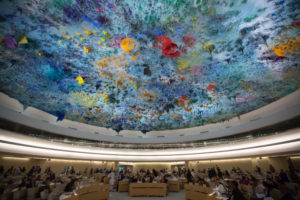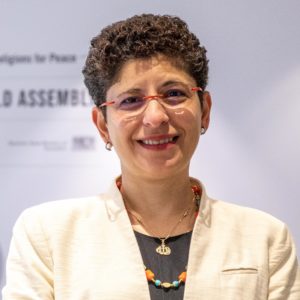
Den här artikelserien är på engelska. För en sammanfattning på svenska, klicka här.
REFLEKTION This text on religion, faith and politics consists of two parts. This first addresses the use of religion in current times when core values of what has built societies and multilateral cooperation are being challenged and brutal force too often is mixed up with power. The second part of the text looks at religion as a double-edged sword, of force and power, which can be both helpful and detrimental i a in peace-building and in dealing with human rights.
The UN to uphold human rights for all – in times when “might is perceived as right”
The United Nations is an intergovernmental organisation meant to represent the interests of all nations. It therefore cannot prioritise any one religion, or speak as advocates for any one religious institution, Instead, it is a secular space advocating for all human rights of all people at all times, and servant to the nations of the world (read: governments).
The world needed such a space after the brutalities and atrocities of the second World War- as well as today in an age where “might is right” seems to be the operating ethos. But this multilateral space still has to learn how to work with religions.
Current time are not unlike the 1930s Europe, except today they are not only a feature of then colonial Europe, but a global phenomenon. We now witness nations with significant military might systematically undermining many human rights (from privacy to the right to health) and subverting the rule of law in their own countries, and globally.
Some nations are annexing territories – and oceans – they claim as their own. Others are literally rounding up certain religious minorities into ‘re-education’ camps (or redefine citizenship rights – of select religious groups- while yet others are busy dishonouring or reneging fundamental and hard won rights of their Indigenous Peoples – and women.
In such contexts, the rule of law, indeed the very legitimacy and viability of all types of modern institutions–political, financial, economic and cultural – may have never been more vulnerable.
Furthermore, multilateral institutions include nation-states considered ‘failed states’, facing a serious challenge of credibility. This weakens the United Nations, whose main pillars are peace and security, human rights and sustainable human development.
The challenge to this multilateral institution is actually a challenge to the very values it stands for and seeks to defend; the very pillars of our human civilisation – as we knew and erected and defended since the second World War.
The threats are further exacerbated by an unprecedented access to information — thanks to all types of media and technology – which is rampant enough to confuse and question any ‘truth’, and the very oxygen our planet breathes and needs.
We live in times when force is considered as power
In his seminal work on Power vs. Force – An Anatomy of Human Consciousness: The Hidden Determinants of Human Behavior, Professor David Hawkins amalgamates several scientific approaches to investigate the nature of consciousness itself [1]. Hawkins’s argument is complex, but the main tenets of relevance here are an appreciation that mind, consciousness, body, muscle, values, and beliefs, social and environmental dynamics, are all part of one whole cosmos – and indeed one being.
The implications of this one-ness, Hawkins maintain, requires us to appreciate not only our interconnectedness as a human species part of a common universe, but also enables our consciousness to distinguish, and react differently, to force, and to power.
Force is for Hawkins, something which “polarizes”, “repels”, “weakens”, is self-serving, involves the sacrifice of others rather than self, and “appeals to our lower nature”.
Hawkins proves how we react differently to force than it does to power. Power can opposite to ‘force’ be “inclusive, attractive, strengthening, principled in its standing for freedom and integrity, is about service to others. In short, power “appeals to our higher nature”[2].
I would wish to utilize this distinction between force and power.
For decades, established democratic regimes have based their credibility and modus operandi on ‘force’ – market force, military force, defensive force, preemptive force, or the force of racial or ethnic or religious superiority.
At the same time ‘new’ centers of financial and military (and militant) force are emerging, some with priorities which appear to harken back to colonial times – where an overt interest in raw materials, control over land and seas, as well as other resources, all dictate the terms of engagement. Other decentralized loci of violence – i.e. of force – are spread out over urban centers in the form of gangs, in some parts of the world, and in silent cells waiting to strike to kill or maim in other parts.
This violence and expressions of force get an inordinate amount of attention in media and elsewhere, On the other hand, there is very limited attention to nurturing, securing conformity with human rights aspirations, democratic ideals, and rule of law. Yet these aspirations of human rights, dignity, adherence to international human rights and humanitarian laws constitute key aspects of ‘power’.
We are living in an era of force. Not of power. An era where religions – as institutions, as leaders of various background, ages and theologies, and as non-governmental and supposedly civic actors – are very much implicated in the myriad vortex of force.
Religions – as Power and as Force
The unique abilities of social mobilization which religious actors have historically been capable of, can and does significantly shift attitudes and behaviors. These shifts can ultimately be conducive to peaceful coexistence between diverse communities – or the lack thereof, and sustainable human and planetary development – or the unsustainability thereof.
Religions pronounce on all aspects of life: dealing with money, material wealth, sexuality, political influence, social justice, and more. As such, religions have the potential to provide guidance to daily life, to social coherence, for solidarity, for justice, peace, and non-violent resistance and tolerance. At the same time, some religious organisations and community groups have their own internal power dynamics; may engage in questionable external outreach; claim absolute truth.
At worse, they go so far as to instrumentalise or allow the use of religion to justify acts of war and outright atrocities.
It is important to recognize both the potential and the risks inherent in the relationship of religions to social, political and financial dynamics. These very same possibilities and dangers are part and parcel – or should be – of engaging religious actors in social and political processes, indeed, in development and peacemaking as a whole.
Here we come to important dilemmas inherent to the governmental engagement with religions in peace building dynamics. There are questions as to the identity and representativity of faith-based actors, particularly relevant given the difference between religious institutions – which are largely male dominated and rife with internal power dynamics – and between in-formal religious actors serving at the heart of their communities, where women often can play a more prominent role.
- With and to whom are we talking when we are speaking with representatives of religious communities?
- Who is excluded from the dialogue and consultation tables?
- To what extent is the governmental outreach taking into consideration, or indeed contributing to, issues of asymmetries of power between diverse groups and communities, by contributing to social inclusion of all – i.e. to power – or silencing and marginalizing some voices?
- To what extent are religious actors contributing to supporting dictatorial regimes, which are sabotaging democratic values?
- Do we absolve actors of responsibility for the rise in xenophobia, religiously motivated violence, stigmatization of ‘others’; whether women, LGBTQI communities, migrants, HIV positive people?
 Azza Karam
Azza Karam
Secretary General at Religions for Peace, previously at IDEA.
Vill du skriva en text där du kommenterar, diskuterar eller kritiserar detta inlägg? Kontakta ämnesansvarig redaktör.
Redaktör: Gerd Johnsson-Latham, klimat och säkerhet; kvinnor, fred och säkerhet.
[1]Arizona: Veritas Publishing, 1998.
[2]Again, important to pause and note that these assertions are based on tests of muscle movement corresponding to different stimuli.

Lämna ett svar